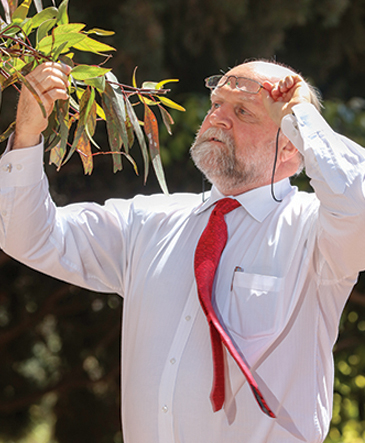The fire next time

Professor Bob Hill Bushfires are a scourge of Australian summers but they’ve also caused the rise of an Aussie icon: the gum tree.
There are fossils of tree kangaroos on the Nullarbor Plain that are just 700,000 years old – so what, Professor Bob Hill wonders, happened to the trees?
This is far from a question for antiquarian environ-mentalists – knowing how the Australian landscape responded to climate change in the past will make it easier to understand how it will respond now. And it will help us to work out what we can do to reduce the damage we’ve done, even restore the landscape to what it was before European settlement.
It’s part of a renewed scholarly interest in Australian botany, paleo and present, which was at risk of sliding into a subset of zoology. “Over the years the disciplines combined and as botany was the smaller it went into decline,” Professor Hill says. “But this is turning around.
“Now there’s a great research interest in Australian botany, in how our vegetation evolved in response to fire, in conservation and in how we can learn about climate change from the fossil records,” Professor Hill says.
When not focused on his research, Professor Hill is also a nine-year veteran as the University’s Executive Dean of the Faculty of Sciences. An Adelaide graduate, his PhD is on Tertiary plant macrofossils and his DSc explored the interaction of climate change and living Australian vegetation. He spent 19 years at the University of Tasmania, a great place for a botanist interested in ancient Australia. “Tasmania was a fantastic place to start my career; there are few places to match it in the world for fossils. In a way I really fluked it,” Professor Hill remembers.
But it took more than luck to build the research record that has made Professor Hill an expert on the interaction of climate and botany in the ancient past and the history of Australian settler society.
He is now a leading member of South Australia’s close-knit botanic community, focused on the city blocks that are home to his University offices, the State Museum and the Herbarium in the state’s Plant Biodiversity Centre, whose different research skills inform the state’s conservation biology effort, which focuses on fire.
Professor Hill is especially interested in what happened in central Australia 40-70 million years back. The fossil records of leaves demonstrate how vegetation responded to climate change and they show that the deserts arrived relatively recently. And the definitive Australian tree isn’t even true blue – eucalypts are just blow-ins on a geological timescale. According to Professor Hill, the earliest eucalypt fossils are from Argentina and New Zealand. They died out there, and nobody knows why, but as Australia dried out they made themselves at home.
Really at home… the eucalypts started taking off 25,000 years ago as rainfall dropped and Australia began to burn.
“Eucalypts are the ultimate fire plants – fire survivors and promoters. They do better in high-fire areas,” Professor Hill says. And since then they have multiplied and diversified and spread across the continent. There are now 800 species of eucalypts, from tiny Alpine plants to the biggest flowering plants on the planet. And they have replaced older Australian plants, which could not compete on a landscape that burns fiercely, and often.
And the changes to vegetation caused by eucalypts over thousands of years are now being compounded by the damage done by European settlement.
No one knows exactly what grew on the Adelaide Hills before the eucalypts, maybe banksias and casuarinas which cope with fires if they are not too frequent, but there was certainly more diversity.
“This makes a really good case for more research on native vegetation so we know what to put back,” Professor Hill says.
But can we, indeed should we, even try?
Professor Hill has no doubt. For a start, restoring the optimum vegetation mix in the Adelaide Hills is in South Australia’s best interests. More original vegetation that can deal with more, but less intense fires, will reduce the devastation of eucalypt-fuelled infernos.
“At the moment, we are responding to once-in-a-generation fires, which now occur more frequently, and it is only going to get worse,” he says.
And it can be done: “Plants are more resilient than people give them credit for. We can change things back with careful planning but we have to work out our priorities.
“If we think vegetation is worth having, it is not beyond us to put it back in place. But it takes willpower and patience, and the problem with humanity is that we lack long-term planning.”
Which is why Professor Hill is optimistic about the future for the next generation of botanists. “There is a lot of restoration that needs to be done, lots of work ahead so we do the least damage to the environment. And hopefully repair some that has already occurred.”
|
|
Media Contact:
Media Office
Email: media@adelaide.edu.au
Website:
External Relations
The 成人大片
Business: +61 8 8313 0814
For more news on the research and educational achievements of the University & our alumni read the University's bi-annual magazine, Lumen.
|
|



